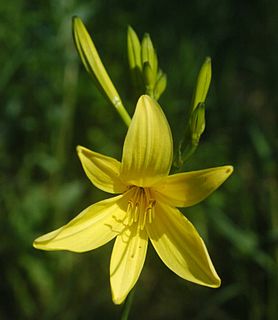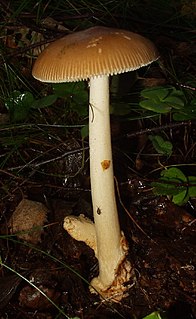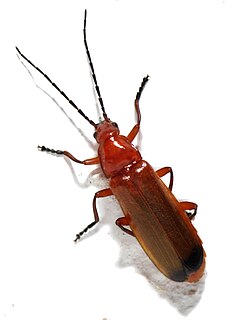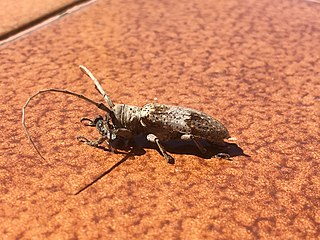Related Research Articles

A daylily or day lily is a flowering plant in the genus Hemerocallis, a member of the family Asphodelaceae, subfamily Hemerocallidoideae. Despite the common name, it is not in fact a lily. Gardening enthusiasts and horticulturists have long bred daylily species for their attractive flowers. Thousands of cultivars have been registered by local and international Hemerocallis societies.

The Pacific Golden-Plover is a migratory shorebird that breeds during Alaska and Siberia summers. During nonbreeding season, this medium-sized plover migrates widely across the Pacific. The genus name is derived from pluvia, Latin for “rain.” It was once believed that golden-plovers flocked when rain was imminent. The Latin species name fulva means tawny or yellowish-brown. In the Hawaiian language, the bird is called kōlea. The Māori of New Zealand call the bird kuriri.

Amanita fulva, commonly called the tawny grisette or the orange-brown ringless amanita, is a basidiomycete mushroom of the genus Amanita. It is found frequently in deciduous and coniferous forests of Europe, and possibly North America.

Ulmus rubra, the slippery elm, is a species of elm native to eastern North America, ranging from southeast North Dakota, east to Maine and southern Quebec, south to northernmost Florida, and west to eastern Texas, where it thrives in moist uplands, although it will also grow in dry, intermediate soils. Other common names include red elm, gray elm, soft elm, moose elm, and Indian elm. The tree was first named as part of Ulmus americana in 1753, but identified as a separate species, Ulmus rubra, in 1793 by Pennsylvania botanist Gotthilf Muhlenberg. The slightly later name U. fulva, published by French botanist André Michaux in 1803, is still widely used in dietary-supplement and alternative-medicine information.

The cave swallow is a medium-sized, squarish tailed swallow belonging to the same genus as the more familiar and widespread cliff swallow of North America. The cave swallow, also native to the Americas, nests and roosts primarily in caves and sinkholes.

Hemerocallis fulva, the orange day-lily, tawny daylily, corn lily, tiger daylily, fulvous daylily, ditch lily or Fourth of July lily, is a species of daylily native to Asia. It is very widely grown as an ornamental plant in temperate climates for its showy flowers and ease of cultivation. It is not a true lily in the genus Lilium, but gets its name from the superficial similarity of its flowers to Lilium and from the fact that each flower lasts only one day.

The common red soldier beetle, also misleadingly known as the bloodsucker beetle, and popularly known in England as the hogweed bonking beetle is a species of soldier beetle (Cantharidae).
Ulmus × hollandica 'Alba' is one of a number of hybrids arising from the crossing of the Wych Elm U. glabra with a variety of Field Elm U. minor. First mentioned by Kirchner in 1864 as U. fulvaHort. var. alba.
Vernaya is a genus of rodent in the subfamily Murinae from southern China and northern Burma. It contains a single extant species, the red climbing mouse, and several extinct species, all described by Zheng in 1993, namely Vernaya prefulva, Vernaya pristina, Vernaya giganta and Vernaya wushanica. The genus is named after Arthur Stannard Vernay who collected the specimen of V. fulva on an expedition to Burma with Charles Suydam Cutting.
The hybrid elm cultivar Ulmus × hollandica 'Fulva' is one of a number of cultivars arising from the crossing of Wych Elm U. glabra with Field Elm U. minor. Originally raised by Hesse's Nurseries, Weener, Germany, it was first mentioned in Mededeeling, Comite inzake Bestudeering en Bestrijding van de Iepenziekte 10: 9, 1932, but without description. Hesse's 1933 catalogue shows both U. fulvaHort. and U. fulvaMichx..

The American elm cultivar Ulmus americana 'Pendula' was originally listed by William Aiton in Hort. Kew, 1: 320, 1789, as U. americana var. pendula, cloned in England in 1752 by James Gordon. From the 1880s the Späth nursery of Berlin supplied a cultivar at first listed as Ulmus fulva (Michx.) pendulaHort., which in their 1899 catalogue was queried as a possible variety of U. americana, and which thereafter appeared in their early 20th-century catalogues as U. americana pendula. The Scampston Elm, Ulmus × hollandica 'Scampstoniensis', in cultivation on both sides of the Atlantic in the 19th and 20th centuries, was occasionally referred to as 'American Weeping Elm' or Ulmus americana pendula. This cultivar, however, was distinguished by Späth from his Ulmus americana pendula.

The red climbing mouse, also known as Vernay's climbing mouse, is a species of rodent in the family Muridae. It is named after explorer and antiques dealer, Arthur Vernay, who sponsored the expedition during which the animal was first discovered. It is the only living species in the genus Vernaya, and has no subspecies.
Ulmus ellipticaKoch is a disputed species of elm, native to the Caucasus, where Koch reported that it formed extensive woods, and ranging north to southern Ukraine. The tree is said to be closely related to U. glabra, but to resemble U. rubra in its samara. Many authorities consider U. ellipticaKoch just a regional form of U. glabra, though Henry, Bean and Krüssman list the Caucasus tree as a species in its own right. U. ellipticaKoch is distinguished from U. scabraMill. [:U. glabra] in some Armenian and Russian plant lists.
Fulvous is a colour, sometimes described as dull orange, brownish-yellow or tawny; it can also be likened to a variation of buff, beige or butterscotch. As an adjective it is used in the names of many species of birds, and occasionally other animals, to describe their appearance. It is also used as in mycology to describe fungi with greater colour specificity, specifically the pigmentation of the surface cuticle, the broken flesh and the spores en masse.

The tawny crazy ant or Rasberry crazy ant, Nylanderia fulva, is an ant originating from South America. Like the longhorn crazy ant, this species is called "crazy ant" because of its quick, unpredictable movements. It is sometimes called the "Rasberry crazy ant" in Texas after the exterminator Tom Rasberry, who noticed that the ants were increasing in numbers in 2002. Scientists have reorganised the genera taxonomy within this clade of ants, and now it is identified as Nylanderia fulva.

Cephalopholis fulva, the coney or the butterfish, is a species of marine ray-finned fish, a grouper from the subfamily Epinephelinae which is in the family Serranidae which also includes the anthias and sea basses. It is found in the western Atlantic. It is associated with reefs and is a quarry species for commercial and recreational fisheries. It can be found in the aquarium trade.
The Brachypsectridae are a family of beetles commonly known as the Texas beetles. There are only two extant genera, Brachypsectra and Asiopsectra. The type species, Brachypsectra fulva, occurs in North America. Other species in the genus have a cosmopolitan distribution. Two other extant and fossil species have been described from the Dominican Republic. While formerly considered monogeneric, in 2016 Asiopsectra was described from specimens found in Iran and Tajikistan. Two extinct genera, Vetubrachypsectra and Hongipsectra, known from adults, and a larval genus, Cretopsectra are known from Cenomanian aged Burmese amber.

Onciderini is a tribe of longhorn beetles of the subfamily Lamiinae.

Oncideres is a genus of longhorn beetles of the subfamily Lamiinae, containing more than 120 species in the nearctic and neotropics.

Oncideres putator is a species of beetle in the family Cerambycidae. It was described by James Thomson in 1868.
References
- ↑ BioLib.cz - Oncideres fulva. Retrieved on 8 September 2014.